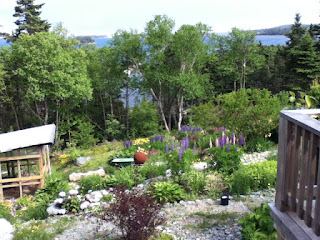SIBERIAN IRIS, DIANTHUS, WOOLY THYME
BEARDED IRIS
MORE DIANTHUS
Monday, July 2, 2012
Wednesday, June 13, 2012
THE MOST WONDERFUL TIME OF THE YEAR
This has to be one of my favorite times of the year for the garden.
The Irises are all bloomin along with lupins,, early day lilies,, chives, forget-me nots, poppies, spiderwort. Daises and pinks will be out in a week along with the 20 Weigela bushes that I can proagated from the two that were on the property when I arrived
Wednesday, May 30, 2012
Monday, April 23, 2012
Friday, April 13, 2012
NEW CONSTRUCTS IN THE GARDEN
Converted a old shed into a greenhouse using old windows that I recycled from the house... should be a paradise for tomatoes :)
Thursday, April 12, 2012
WHATS ON THE 2012 GARDEN MENU....
STRAWBERRIES
HIGH BUSH BLUEBERRIES
GOOSEBERRIES
RED LAKE CURRANTS
RED POTATOES
ZUCCHINI
SWISS CHARD
EARLY FROST PEAS
BOSTON CRUNCH LETTUCE
RHUBARB
PLUS MORE... TO COME
CURRANT EVENTS
Red lake Currants (Ribes rubrum)
Red Lake Currants are considered to be the best red cultivar. The later ripening, large bright red fruist are borne in long stemmed clusters, which make for easy harvesting. Plants are vigorous, stron and usuaully more productive than other cultivars.
Pruning
Red Lake Currants are considered to be the best red cultivar. The later ripening, large bright red fruist are borne in long stemmed clusters, which make for easy harvesting. Plants are vigorous, stron and usuaully more productive than other cultivars.
Fertilizing
Stable
manure is the best fertilizer for currants
Young
plantings do not need much manure. After
the plants start bearing fruits, apply ½ bushel of manure per bush annually.
If
stable manure is not available, use green manure or mulch to maintain humus
supply. Commericial fetilizers can be
substituted for manure to supply nutrients.
Apply approx 100 to 150 grams of 10-10-10, or 12-12-12 per bush annually. Apply late in fall or early in spring before
growth starts.
Pruning
Prune
when the plants are dormant in the late winter or very early in the spring
before growth begins. The plants are bush-like, varying in height from 2-5
feet. They bear some fruit near the base of 1-year-old wood and produce the
most and best fruit on spurs of 2- and 3-year-old canes. At the end of the first season, remove all
but 6 or 8 of the most vigorous shoots. At the end of the second season, leave
4 or 5 1-year shoots and 3 or 4 2-year canes. At the end of the third year,
keep 3 or 4 canes each of 1-, 2-, and 3-year old wood. This will make a total
of 9-12 canes on each plant.
Canes
4 years and older produce very little fruit. Pruning mature plants, therefore,
should consist of thinning out the old “fruited-out” canes and he weakest of the
young canes. Cut them off at ground
level. Remove canes over 3 years old, and by thinning, select the proper kind
and number of younger canes to maintain a productive bush. If properly pruned,
a dormant bush will have 6-10 bearing canes plus 3 or 4 new ones coming along
to replace the oldest each year.
Tuesday, January 24, 2012
Seaweed
Seaweed is a wonderful vegetable garden fertilizer, a great soil builder and an excellent compost activator. Seaweed contains complex carbohydrates and these really get the soil humming with life. This has two really important functions for the garden, firstly it stimulates the microbial fungi in the soil and these assist plants in their uptake of nutrients, they also assist in defending plants from soil born diseases. So adding a seaweed fertilizer helps crop protection, and plant nutrition.
It can be either applied to the soil as a mulch (although it will tend to break down very quickly) or can be added to the compost heap, where it is an excellent activator.[2] In terms of soil structure it does not add a great deal of bulk, but its jelly like alginate content helps to bind soil crumbs together, and it contains all soil nutrients (0.3% N, 0.1% P, 1.0% K, plus a full range of trace elements) and amino acids.
THE DIRT ABOUT THE DIRT
Specific Plant Nutritional Requirements
Rhubarb - soil ph range 6 to 6.8
high nitrogen requirement
5-10-10 fertilizer in the spring
Grapes - soil ph range 5. to 6.
Well Drained Soil
10-10-10 fertilizer in spring
High Bush Blueberries - soil ph range 4.2 to 5
Well drained soil.. lots of organic matter
nitrogen, Potassium and phosphorus
Specific Plant Nutritional Requirements
Rhubarb - soil ph range 6 to 6.8
high nitrogen requirement
5-10-10 fertilizer in the spring
Grapes - soil ph range 5. to 6.
Well Drained Soil
10-10-10 fertilizer in spring
High Bush Blueberries - soil ph range 4.2 to 5
Well drained soil.. lots of organic matter
nitrogen, Potassium and phosphorus
Subscribe to:
Posts (Atom)









































